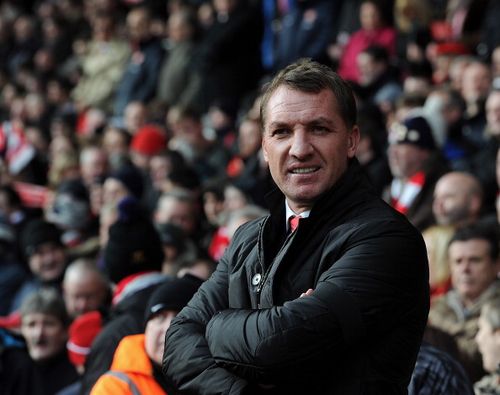
Talking tactics: How Rodgers masterminded Liverpool’s demolition of Arsenal

Rodgers: Tactical genius
When the doors to the Premier League were left ajar to the rest of Europe on 15 December 1995, following the approval of the Bosman ruling, many people on these shores were hoodwinked into believing that stylish, elegant and technical football belonged to the imported elite (who arrived in their droves), long-ball tactical philosophies were better suited to the hard working physical players found up and down the country and, by adding a pinch of overseas talent, a manager’s deteriorating tactical system would suddenly and magically be transformed for the better.
But, while all those nonsensical thoughts were happening, the year in which the European Court of Justice passed Bosman’s request, altering the face of football forever, was especially significant for Brendan Rodgers, who started down the road of football management as Academy manager of the Reading youth team.
For some, the notion of implementing a distinctly continental style of football is a thing of myth and mystery; something unattainable, out of reach, beyond all comprehension. However, for Rodgers, who has refined his tactical ideologies since that pivotal day in 1995, this fantasy has become a reality. A reality that was shown to the world on Saturday, when Liverpool trounced Arsenal 5-1 at Anfield.
It was only the second time since their inception that Liverpool had beaten the Gunners by that scoreline, mirroring the pair’s clash on 1 January 1910 when, in front of a crowd of around 25,000, Liverpool defeated Woolwich Arsenal (the name Arsenal used until 1914) 5-1 under the guidance of Tom Watson – the man who led Liverpool to their first ever First Division title in 1900-01.
Watson would have enjoyed being able to witness the stylish football on show from Rodgers’ Liverpool, although he would have probably been confused at the modern-day tactics on show. Nevertheless, the manner in which Rodgers triumphed over Arsène Wenger should be celebrated, commended and applauded by the Liverpool greats of this century, and the last.
Fluid Shape of Seven Lines

Rodgers seeks seven lines of passing options.
During his time at Swansea City, Rodgers spoke of his preferred tactical philosophy, which he studied on trips to Holland and Spain – notably at the Barcelona academy – following his early retirement from playing football at the age of 20. In open and honest interviews with the press, in which he would outline his preferred beliefs, he was quick to emphasise that any formation should include multiple lines of players, thus creating various angles for diagonal passes, with each player having received the ball, being able to pass to two teammates (at least) regardless of the chosen formation employed by the manager.
A keen advocate of wing-backs surging forward, Rodgers’ 4-5-1/4-3-3 formation creates seven lines from defence to attack, increasing the layers that help with ball retention.

Coutinho and Gerrard act as staggered playmakers.
By staggering his players in the manner, Rodgers also attempts to combine the attacking and defensive transitions into a fluid beast, utilising intense pressing in an effort to win the ball back at the earliest opportunity – targeting and inflicting pain on a disorganised and unsettled opponent – followed by a rapid retreat to deep, defensive positions in order to protect the goal.

An example of Liverpool’s 4-1-4-1 shape when possession was lost.
During their 5-1 demolition of Arsenal, Liverpool implemented all of the above impeccably.

Liverpool’s 3-4-3 shape when possession was regained.
When possession was lost, the Reds formed a defensive barricade in front of goal by retreating into a 4-1-4-1 shape (see above) – a perfect shape for a counter-attacking strategy, due to the close proximity of the wide midfielders and wing-backs – as Luis Suárez and Raheem Sterling marked Nacho Monreal and Bacary Sagna down the left and right flank respectively, with captain Steven Gerrard barking orders in front of the centre-backs.

Gerrard switches play from deep, with Flanagan acting as inside forward.
Then, when a tackle or interception was completed and possession regained, their shape morphed into a 3-4-3 formation as Jon Flanagan and Aly Cissokho joined Jordan Henderson and Coutinho in central midfield (see above), with Suarez and Sterling interchanging with Daniel Sturridge in a three-pronged attack.
Possession regained, Gerrard retreats to create a three-man defence and the wing-backs move to join the midfield, roaming high on either flank while Gerrard switches play as the primary playmaker (see above). Possession lost, Gerrard pushes forward (five in midfield) and the wing-backs recoil to create a traditional back four.

Gerrard creates a back three, with Coutinho helping out.
An efficient system which, on its day, is a joy to watch.
Before moving on I really need to emphasise the diligent work carried out by Suárez down Liverpool’s right flank in the 4-1-4-1 defensive shape.

Again, the 4-1-4-1 shape on show, with Suarez tracking Monreal (far side).
The 27-year-old Uruguayan may be better known for his prowess in front of goal, but in Suárez, Rodgers has a tactically adept player who carried out the instructions methodically and consistently throughout the entire 90 minutes. His work rate was immense, as always, but the forward’s willingness to track Monreal’s advances should be commended – but probably overlooked by fans and certain sections of the media – as it helped bind the mutating tactical system together, offering an offensiveand defensive contribution in equal measure. Even though I’m sure he would have preferred to spearhead each and every attack.
Suárez’s defensive work rate helps, unsurprisingly, with the defensive aspects of the game – tracking runners, along with aggressive pressing – while his dribbling expertise is a great asset for the counter-attacking strategy that Rodgers has instilled into the side.